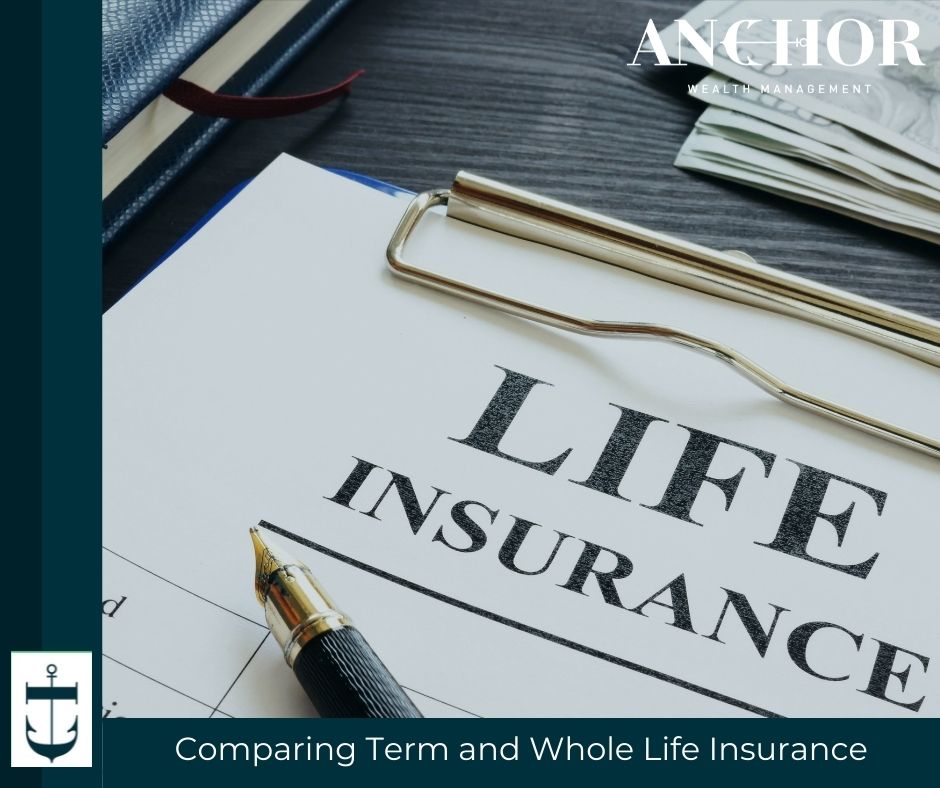
For something that’s so important, it’s hard to imagine why insurance can be so complicated, especially when it comes to life insurance. The general idea of insurance is to provide you with financial coverage when faced with an accident or unforeseen event. However, due to high premiums and difficulty understanding different policies, people often find themselves without the coverage they need. Here at Anchor Wealth Management, we understand that choosing a life insurance policy that’s right for you is important and you likely don’t want to be spending any more money on it than you have to. But before you can choose a life insurance policy, you need to understand the difference between term and whole life insurance.
What Is Life Insurance?
When you start a life insurance policy with your insurance company, you will make premium payments in exchange for a lump-sum payment called a death benefit upon death. This payment is given to the listed beneficiaries of the insured person. The policy that you choose will depend heavily on your age, income, and goals, so it’s important not to jump to any conclusions and speak with a financial advisor before committing.
Term Life Insurance
Just like the name suggests, term life insurance only provides financial protection for a specific time period. This period is usually around 10 or 20 years. A traditional term insurance your premium will remain the same for the duration of the period that you’re covered for. Once the period has ended, you can still receive coverage, but it will be at a much higher rate. Generally, term life insurance is more affordable than whole life insurance.
Term insurance provides income replacement during working years, typically fixed premiums, and the proceeds paid to beneficiaries are usually income tax-free. Generally speaking, a term life insurance policy is good for a younger person who is the primary earner in their family and only needs coverage for a set period of time. If the term life insurance policy contains a conversion privilege, you will be able to change to permanent insurance while keeping the same rate you had at the beginning of the policy.
Whole Life Insurance
Whole life insurance stays active as long as you continue to pay premiums. It is a type of permanent life insurance and is generally more complicated than term life insurance policies. One thing that’s important to understand with a whole life insurance policy is the term cash value. This refers to an investment-like product that is matched with the policy. It can vary depending on the coverage. As an example, in a whole life policy, the cash value is similar to a simple savings account whereas, in a variable life policy, it’s similar to a mutual fund.
When you pay a premium, part of the money goes to the death benefit while part of it goes to the cash value. The cash value can then be used for things like funding the policy itself, using it for retirement, or taking out a loan. So, the question then becomes, “why not pay for insurance separately from your insurance?” In reality, this will be a better idea for most people since whole life insurance can sometimes be six to 10 times the cost of term life insurance.
Key Differences
Duration
With a term life insurance policy, you will be paying for a period of time usually between one and 30 years in increments of five years. This is best for most people because after 30 years they tend to have fewer financial obligations and they are able to self-insure with savings. If you have a term conversion rider, you can always convert your term insurance policy to a whole life policy and benefit from indefinite coverage.
Cash Value
Term life insurance policies don’t include a cash value. As a result, they’re easier to decide between but you won’t experience the minimum growth rate that you’ll get with a whole life insurance policy.
Premiums
Since whole life premiums are level, you’ll never have to worry about them going up. However, with a term life policy, there is both annual renewable and guaranteed level. Renewable annual policies have premiums that increase over time whereas guaranteed level term life insurance has premiums that stay the same for a given period of time.
Why We Do Not Offer Whole Life Or Cash Value Life Insurance
Now that you have a general idea of term and whole life insurance, let’s zero in on our offerings here at Anchor Wealth Management. First, it’s our belief that people don’t need to pay for life insurance forever. The purpose of having life insurance in the first place is to get from point A to point B.
Point B is where a person with sufficient investments or a nest egg can provide for the surviving family in the event they lost a spouse. At this stage, a person is self-insured. Whole life insurance, in my opinion, shouldn’t be used as an investment and people are better off paying less for term life insurance and investing the difference they save from not paying for whole life.
Speak With A Financial Advisor
As you can tell, life insurance policies are never as simple as they should be. If you’re considering getting coverage, don’t jump into anything without consulting a financial advisor first. Our financial experts at Anchor Wealth Management will help you find the policy that makes sense for you and your goals. Give us a call today to get started.
